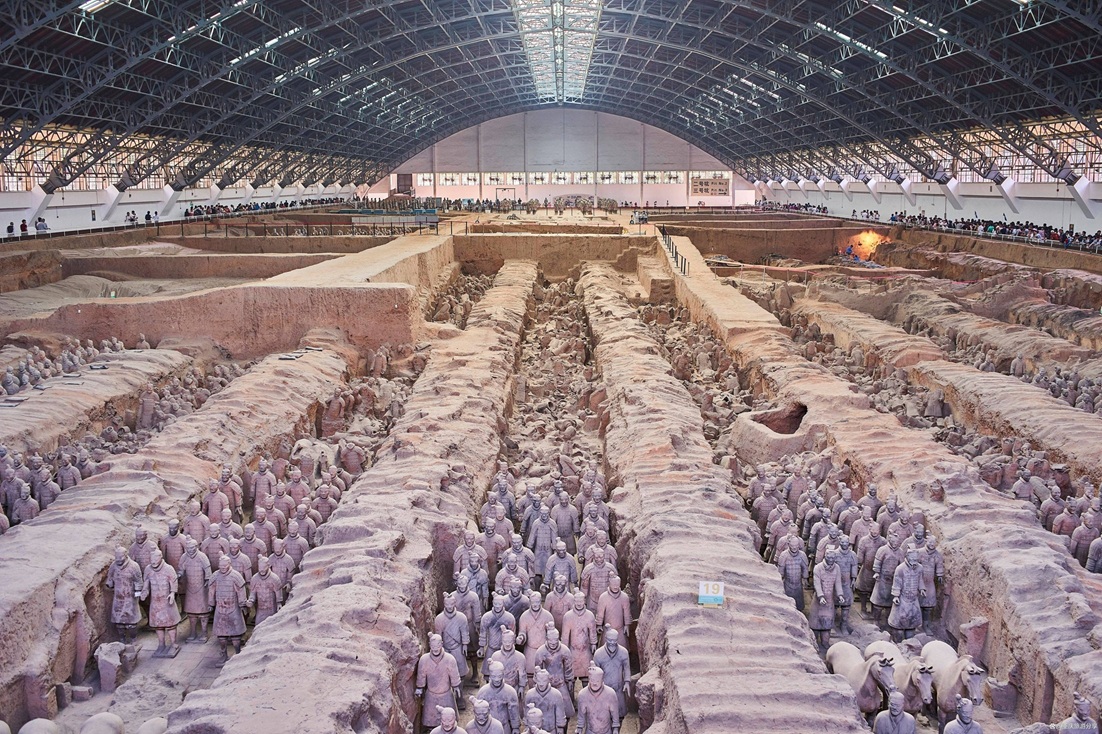In the long river of Chinese history, there is a place that carries profound history and endless astonishment — the Xi’an Terracotta Army.
As you approach the site of the Terracotta Army, the grand scale first makes you gape in awe. Pit No. 1 is the largest of the pits, resembling a huge underground military camp. At a glance, thousands of life-sized terracotta warriors are neatly arranged, with a well-ordered military formation. The front row of warrior figures, each clad in armor and holding weapons, gaze resolutely ahead as if waiting for the call to march. Row upon row and column upon column of these terracotta figures stretch endlessly, like a sleeping giant dragon lying underground for a thousand years. Although Pit No. 2 has limited excavation, the exposed part is enough to make you feel its majestic momentum. Various types of troops with different functions are mixed together, including charioteers, cavalry and infantry, which coordinate with each other to show the ingenuity of ancient military deployment. Pit No. 3 is relatively small, but judging from its layout, it should be the command center of the entire underground army. The feeling of its small size yet crucial importance in commanding the whole situation is overwhelming.
Each of these terracotta warriors is a unique artistic treasure, with profound historical significance behind them. They were born over two thousand years ago in the Qin Dynasty, as burial objects for the Mausoleum of the First Qin Emperor. The Qin Dynasty was a powerful dynasty that unified the six states and dominated the seas. Emperor Qin Shi Huang, with his great talent and extraordinary ruling power, established the first unified feudal dynasty in Chinese history. These terracotta warriors are a symbol of his attempt to continue ruling the world after death and an extension of his majesty and power. They witnessed the highly developed pottery-making technology of the Qin Dynasty. The facial expressions, hairstyles and costumes of each warrior are meticulously detailed. The lifelike demeanor, some solemn and serious, others slightly smiling, makes it seem as if these terracotta figures are not made of cold clay, but real Qin soldiers who have traveled through time and space.
Standing at the site of the Terracotta Army, the astonishment hits your soul directly. The surroundings are so quiet that you can only hear your own breathing. Yet in this silence, you can feel the noise of the ancient battlefield with clashing weapons. It seems as if you can see these soldiers marching neatly on the battlefield, their footsteps shaking the earth and their battle cries piercing the sky. Sunlight streams through the glass of the exhibition hall and falls on the terracotta figures, with light and shadow intertwining. History and reality seem to overlap. These terracotta warriors are not just cultural relics; they are a three-dimensional history book, silently telling the glory and vicissitudes of the Qin Dynasty. They carry the hard work and wisdom of countless craftsmen and are the crystallization of the great creativity of the ancient working people. In this rapidly changing modern society, the Terracotta Army is like an eternal lighthouse, allowing us to travel through thousands of years of time, to feel the strong pulse of ancient China and the unique charm of that great era. This astonishment will forever remain in the hearts of every visitor, becoming the most profound and intuitive memory of history.
Character Introduction:
There is no specific single protagonist. The story is told from a macro perspective about the Terracotta Army. Ancient craftsmen can be regarded as indirect protagonists. They were highly skilled, shaping vivid figures out of clay.
Emperor Qin Shi Huang: The founding emperor of the Qin Dynasty. His great talent and vision led to the construction of the Terracotta Army. He was majestic and had strong ruling power, hoping to continue the glory of his life after death.Story Outline:
The article mainly focuses on the Xi’an Terracotta Army. It first describes the grand scale seen when approaching the site. Each of the pits — No. 1, No. 2 and No. 3 — has its own characteristics, showing the magnificence of the underground army. Then it tells the historical significance of the Terracotta Army. It originated in the Qin Dynasty as burial objects for the Mausoleum of the First Qin Emperor, witnessing the rise and fall of the dynasty and reflecting the pottery-making technology and the hard work of craftsmen at that time. Finally, it emphasizes the astonishment felt at the site. It acts like a bridge connecting the past and the present, enabling people to touch the charm of ancient China.
Analysis Report:
Theme: The theme is clearly focused on the Xi'an Terracotta Army, aiming to show its grand scale, profound historical background and the astonishing feeling on site. The article well fits the theme through the description of the Terracotta Army, the explanation of its historical significance and the expression of the on-site feeling.
Plot: Although there is no traditional plot development, the narration follows the order of introducing the overall scale, exploring the historical significance and expressing the astonishing feeling on site. The logic is clear and the structure is well-organized.
Characters: Although there is no character development in the traditional sense of a story, the brief introduction of ancient craftsmen and Emperor Qin Shi Huang helps enrich the historical and cultural connotations of the Terracotta Army, enabling readers to better understand its significance.